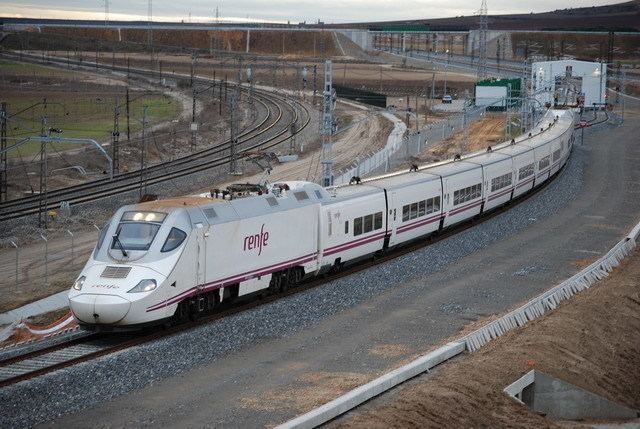Number built 45 Train length 183 m (600 ft 4.7 in) | Operator(s) RENFE | |
 | ||
Manufacturer Talgo / Bombardier (Kassel) Capacity 11 coach set:
299 seats, 236 standard, 62 first, 1 special Car length 20 m (65 ft 7.4 in) (power car)
13.14 m (43 ft 1.3 in) (passenger car) | ||
The RENFE Class 130 or S-130 (Spanish: Serie 130 de Renfe, manufacturer's designation Talgo 250) is a high-speed dual-gauge, dual-voltage trainset consisting of 11 Talgo VII tilting coaches and two power cars, used on Alvia services. The class have been nicknamed patitos (ducklings), due to the shape of the train nose.
Contents
Background and design
The trainsets are designed for high-speed services on Iberian gauge (1,668 mm (5 ft 5 21⁄32 in)) and high-speed (1,435 mm (4 ft 8 1⁄2 in)) lines; they can change gauge at low speed without stopping using Talgo's RD variable gauge system. The carriages are constructed from aluminium and incorporate the Talgo Pendular passive pendulum tilting system, are sealed against pressure differences for tunnel travel, and have underframe air conditioning, individual audio systems and video displays, rotating and reclining seats and power outlets.
Capacity in standard class is 36 seated, in first class 26 seats, end coaches have lower capacity, one coach is typically used for restaurant/sales services.
The locomotives use AC traction motors controlled by IGBT inverters which include integrated auxiliary inverters. Signalling systems can include ETCS Level 2, LZB, ASFA and Ebicab900TBS.
Operations and services
As of January 2010 they operated from Gijon/Oviedo via León, Palencia, Valladolid to Madrid with some trains extended to Alicante via Albacete; Santander via Palencia and Valladolid to Madrid, sometimes extended to Alicante; Madrid to Bilbao via Valladolid and Burgos; Madrid to San Sebastian/Irun via Valladolid, Burgos and Vitoria; and Madrid to Alicante; Huelva and Cadiz.
On services such as Gijon-Madrid they have been replaced by RENFE Class 120 trainsets (2011).
RENFE Class 730
In order to extend high-quality services to parts of Spain not on the high-speed network RENFE acquired hybrid trains with both electric and diesel power for delivery in 2012 for use from Madrid to Murcia and Galicia, built by Talgo and Bombardier, at a cost of 78 million euro. The new trains based on the S-130 were initially coded S130H, later S730;
Fifteen sets S-130 units will be converted to hybrid operation. with two generator cars per set using MTU 12V 4000 R43L engines (1.8MW each). The top speed in diesel mode is 180 km/h. Testing of the trains took place in 2011 with introduction into service expected in 2012.
250km/h+ prototype train
A gauge-changing train capable of over 250 km/h is in development and is based on the S-130.
Uzbekistan trainset order
A version of the S130 for Uzbekistan Temir Yollari was ordered in 2009 for use on a Tashkent–Samarkand high-speed line. Deliveries of the order of two trains began in July 2011.
2013 Santiago de Compostela accident
On 24 July 2013 a RENFE class S730 running as the Alvia 4155 service from Madrid to Ferrol derailed and crashed near Santiago de Compostela in north-western Spain, killing 78, out of 218 passengers on board. The cause of the accident is not yet officially determined, but the train was alleged to be traveling over twice the posted speed limit while entering a curve, due to the absence of ERTMS.
